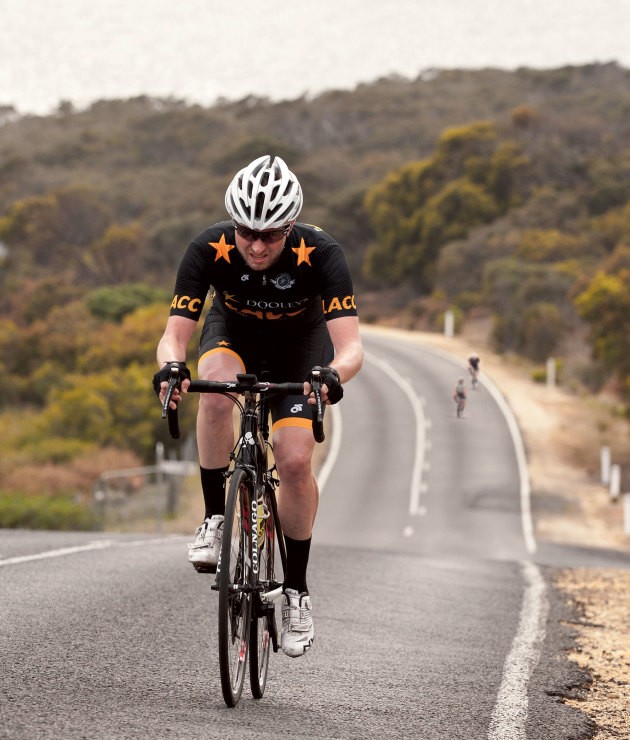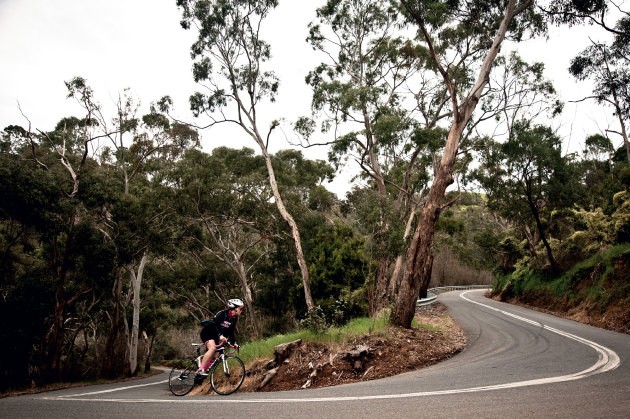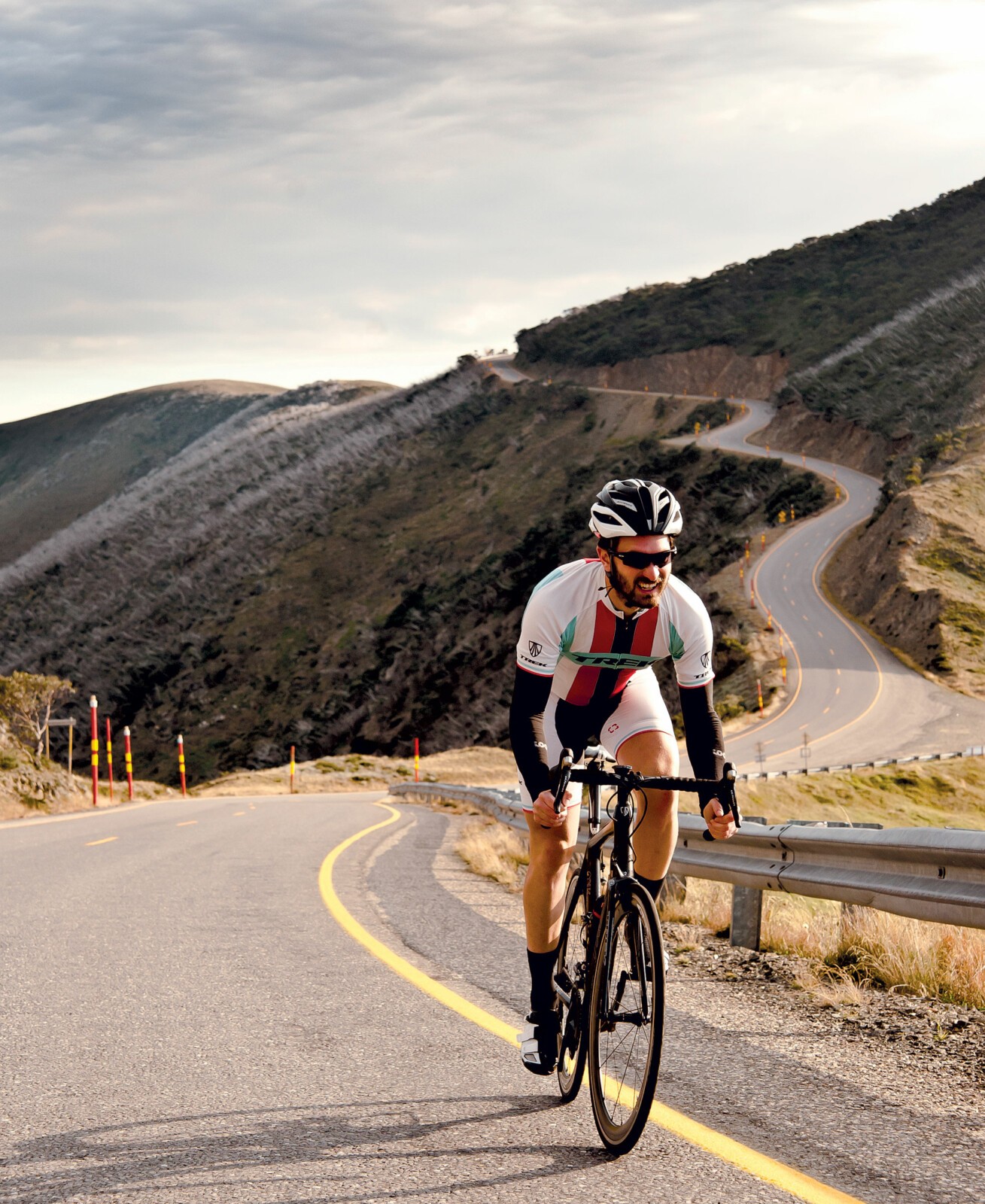I had a client approach me. He told me the story of how he used to be stronger than all his cycling buddies, but over the course of about a year, they had got the better of him and now each and every ride he did with them he was being smacked over by them. All of them.
His buddies started talking about going over to Europe and riding some of the stages of the Tour de France while it was on. He loved the idea of going over there and riding some of the classic climbs. On one hand he was inspired by the idea and on the other, he had just 12 weeks and was filled with a great deal of trepidation at the thought of getting there and being left behind on the climbs.
In this article I discuss some pointers to help your hill climbing.
Develop Your Core Strength
Improving your overall biomechanical function will make a big difference to your riding. With many of my clients being desk bound it’s become even more important in recent years. It helps with all aspects of your cycling, but it impacts the most on your ability to be able to put out sustained power efficiently over longer climbs.
There are many “core strength” exercises around, but the ones that you’ll want to look for are exercises that are performed when you are face-down or facing forward. These mimic the position that you are in while riding. Exercises that are performed face-up, while still good core strength exercises, do not replicate the position that you are in while cycling so, therefore, don’t usually translate well in helping you develop good hill climbing strength.
Here is a list of things to look for in core strength exercises:
• Exercise that provide forces that load you diagonally across your body
• Exercises that are done with free weights rather than machines
• Exercises that involve standing on one leg
• Exercises performed with your face down or facing forward
• Exercises that are done using multi-joint movements
Do a search for Matt Brindle Functional Strength training for cyclists for more in-depth information.
Get a Grip
There are two hand positions that we use for hill climbing.
The first position is called ‘on the hoods.’
The second position is called ‘on the tops’ with the thumbs wrapped around under the bars.
As simple as it seems, it’s really important to get these two positions right as they form the foundation for developing a sound and stable base in which to develop solid power and great form while climbing.
Both positions help you to open up your chest, ensuring that you can breathe as deeply as possible and can oxygenate your blood to maximise your climbing speed. Out of the two positions, the ‘on the tops’ position provides the best position for opening up your chest.
Take a Seat
Climbing in the seated position is more efficient than standing. The reason for this is that you use fewer muscles when seated on the bike than when you are standing.
On longer climbs, it is best to stay seated as much as possible to be efficient. It’s also the preferred climbing style for women; no disrespect intended, but generally women aren’t as strong in the upper body as men to support long stints out of the saddle.
Please be Upstanding
Standing is used when you need to develop short bursts of power. I recommend that you stand when you have to punch over short climbs and through short, steep sections of a climb.
If you are lightly built like me, standing while negotiating short sections of a climb is no problem; you’ll be able to dance on the pedals.
But if you are carrying more weight than necessary on your upper body, you’ll struggle to stand for anything longer than a few minutes.

Spend time working on your technique
If you are riding hills flat out all the time, you’ll be riding far too hard to focus on your form and technique. You won’t notice whether you’re pedalling correctly or not.
Smashing yourself up hills with poor form trains an inferior neurological recruitment of muscle fibres. Training these bad habits will result in robbing you of developing valuable climbing power.
By training your hill climbing technique properly, you can uncover your hidden cycling speed and start to climb hills far better than you thought possible. In races, you’ll be in control rather than reacting. In bunch rides, you’ll just ride away from your buddies.
The first thing is to climb a hill slowly on your bike. This gives you an excellent opportunity to review your technique. The beginning of your season is an excellent time to check your technique.
Smooth is Fast
Efficient power climbing is developed from smooth, powerful, relaxed pedal strokes. For longer hills, stay seated and keep your cadence above 75 rpm. Keep your hands on the tops or the hoods, or alternate between both positions. For shorter climbs, practice standing and keeping good balance, form and driving power straight down into the bike.
Initially, you’ll want to keep your cadence high to work on your technique. Concentrate on spinning, even when out of the saddle and rock the bike gently beneath you as you turn the gear over. By doing this, it will not only work on your technique but also your aerobic conditioning.
Once you have your climbing technique mastered at high cadences, then start dropping your cadence to start to develop your hill climbing power.
The final step is to combine the two together – good technique and climbing power – and start climbing at higher intensities. Build initially from short climbs to longer climbs and continue to keep good form. Don’t sacrifice good form for speed, and it will serve you well in the long term.
To perfect your seated climbing pedal stroke, you don’t need to electronically analyse your pedal stroke to tell you what’s going wrong.
First thing, get yourself well-grounded on the seat. I want you to try this. Jump on your bike on the road or home trainer. Sit on the saddle, ground yourself to your bike and start pedalling.
Now you want you to start to pedal around in circles with a little load. I want you to pay particular attention to scraping your foot through the bottom of the stroke, like scraping chewing gum off the sole of your shoe.
Once you have that sorted, I want you to focus on the top of the stroke and focus on dragging your foot over the top of the stroke.

Now put it all together
Try to pedal through the full stroke, over the top, down through the stroke, and then finish it off by dragging your foot through the bottom. And repeat.
The first thing you’ll notice is that you can only do this with your core locked. Work on keeping your hips as stable and as straight as possible. Let your legs drive from this stable platform. Have your hands rest lightly on the bars. It’s hard work when you start doing it for the first time.
Most people only have enough core strength to keep it going for around 15 seconds.
So, your goal is to work on this technique on every single ride you do until you can do it for hours. It may take you months, maybe years. But as you master this, you’ll find a heap of climbing power that you never knew you had.
You’ll also be able to use it when riding along the flat. I can’t stress how important this is. If there is only one thing that you master from this article, then this is it. It will improve every single aspect of your riding.
When you get up out of the saddle, imagine that there are steel rods running down each side of your back, making it rock solid. Stabilise your hips and drive again down into your bike from that solid platform you have made with your hips.
Moving slightly forward you use more of your body weight to work the pedals. This is good for longer climbs, but for shorter climbs sit a little back, so you engage your gluteus and really drive down into the pedals, all while keeping the back and hips as stable as possible.
Keep your hands firmly gripping the bars. On really steep hills of 10 percent and more, you’ll need to grip those bars and use them as a brace to leverage and support your locked back and hips and drive into the bike with even greater power.
Slide
Reducing fatigue on climbs is paramount, and it becomes especially important the longer the climb. Reducing the fatigue on your body on climbs helps you to maintain your climbing speed for longer.
You can adjust your position on the saddle and by doing so, you can emphasize some muscles you use while relieving others.
By moving to the rear, you can accentuate the strong gluteus muscles in your butt and push the pedals forward as well as down.
When you’re feeling too much muscle tension, tightness, or soreness, slide forward towards the nose of the seat. Now you can engage the quadriceps muscles in your thighs, and you can increase your cadence, and your gluteus can recover.
Sliding back and forth like this fights fatigue and makes the most of your energy. It also changes pressure points to improve your saddle comfort.

Cadence
One of the most effective ways to get the most out of your cycle training for endurance events is to keep your cadence high. What I’m talking about here is maintaining your cadence around 90–100 rpm on the flat roads while keeping it above 65 rpm on hilly roads (where your gearing permits).
By doing so, you’ll help build your cardiovascular fitness and reduce the amount of fatigue you’ll get during your ride. This is the first thing we get all our clients to do when they start on our coaching programs.
Now, the physiological reason for a high cadence is very simple. As you increase your cadence, you rely more on your cardiovascular fitness and your endurance muscle fibres (that are designed to work all day) to drive the bike.
As you lower your cadence below 80 rpm, you rely more on your muscular strength using your strength muscle fibres. While these strength fibres deliver more short-term power than your endurance muscle fibres, they also fatigue more quickly.
Slow it Down to build strength
Ground yourself on the seat, stable hips, locked core, strong full-stroke pedalling action focusing on the top and bottom of the stroke. Start out with your cadence at 80. Then, over time, drop it to 70, and then 60, then 50, then 40 rpm over time.
The best way to do this is to find a hill around five minutes long at a gradient of around 4–7%. Start out doing around six repeats on it at 80 rpm, once every week for two weeks. Then drop your cadence to 70 rpm for another two weeks … I think you get the pattern. Over time, you’ll develop your strength.
Remember that during this phase of your training you many find that you’ll start to slow up. It is also important to balance this big chain ring cycling power training with high cadence recovery bike rides.
Too much big chain ring work is like doing too much weight training at the gym. You will trash your legs because you don’t give them the chance to recover properly, and it will slow you down. Try not to do much big chain ring work and certainly don’t spend hours grinding away on the pedals.
Big chain ring work can also be done on the home trainer. Anything that has intervals with cadences of 70 rpm or lower is great. We have a heap of these video sessions that I pass out as part of the training programs so my clients get the best from their trainer and improve their technique and climbing speed.
Well, I hope that provides a few pointers to help you climb better. If you have any questions, you can contact me at support@cycling-inform.com. All the best with your hill climbing.








